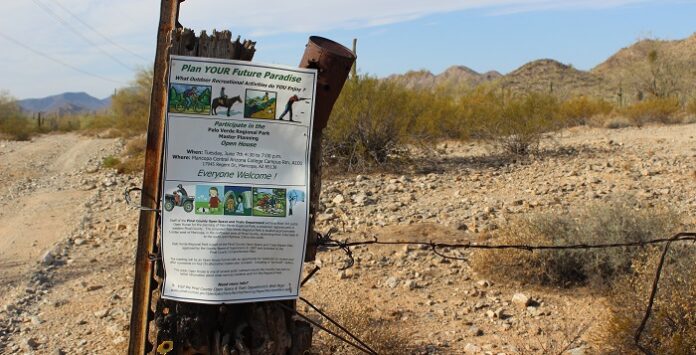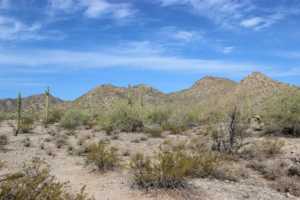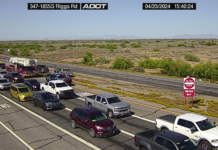
By Ethan McSweeney
Shirley Ann Hartman has lived in western Pinal County for 56 years, calling the rolling hills and desert washes in the area home.[quote_box_right]To leave a comment on the four alternatives for the Palo Verde Regional Park, go to this link. The deadline for comments is July 15.[/quote_box_right]
So, when Pinal County approved its open space plan that would include some of the land along the western edges of the county as a protected Palo Verde Regional Park, she joined in to do her part. She saw it as a way to preserve the land for future generations. As part of the Pinal Partnership Open Space and Trails Advisory Committee, Hartman worked with other citizens to help design the park.
Hartman and other supporters of the park didn’t expect that a vocal opposition would form among some residents in the area.
“I’ll be honest: I’m shocked,” Hartman said of the opposition. “I would think it would be, ‘Yes, let’s do this.’”
Led by Joe Witinski, a resident of Hidden Valley near where the Palo Verde Regional Park would be, residents have started petitions, packed public meetings and erected signs around the area in opposition to the county’s plan.
The residents opposing the park see the move as a “land grab” by the county that would burden taxpayers and charge people to go on land they already can use for free.
“All they would do is deny … regular users access to land they use all the time,” Witinski said.
In 2007, the Pinal County Board of Supervisors approved the Open Space and Trails Master Plan, which would designate areas around the county to be regional parks to be managed by Pinal County. Among those parks is the Palo Verde Regional Park.
More than 23,000 acres of land running along the western boundary of Pinal County from Interstate 8 to the south to State Route 238 to the north is designated for the park. That would include the Palo Verde Mountains, the Haley Hills and the Vekol Wash — land that’s currently owned by the federal Bureau of Land Management (BLM).
As part of the process for creating the park, public input is being sought on four proposed plans, called alternatives, for how the park could look when it opens. Each alternative has different degrees of infrastructure that could be developed in the park. The deadline for residents to submit comments on the county’s website is July 15.
The alternative that’s selected would then need to be approved by the Board of Supervisors. The approved proposal would be included in an application for management of the land to BLM, said Kent Taylor, director of Pinal County Open Space and Trails.
Taylor said he expects the plan could go before the Board in the fall.
Opposition among some residents

Witinski, who has lived in Hidden Valley since 2001, said when he heard about the plan to turn the land into a county park, he was confused. The land, as it’s managed now, is available for the public to use for free, and turning it into a regional park would only add costs to residents who want to use it and the county that wants to manage it, he said.
“I’m going to have to pay to use my backyard,” Witinski said. “There doesn’t seem to be an advantage to it. The excuse [supporters] give is that they’re trying to protect it from being leased out to a developer, or mining, or for solar and that’s clearly not what’s going out here.”
Witinski launched a Facebook page called Citizens Against Palo Verde Regional Park, which has garnered about 120 likes and posts updates about the progress of the park and perceived deceptions by county officials. He also circulated a petition against the park that he said has accumulated more than 560 signatures.
He and other opponents to the park have also attended public events and meetings to make their opposition known to county officials, including at the Palo Verde Regional Park Open House last month, where they held signs with phrases such as “We Don’t Want Any Park!”
Witinksi said he believes the county’s planning process for the park has also been carried out poorly.
“It’s been ill-conceived from the start and ill-executed,” he said. “I want to hold people accountable for this.”
Angela Villa, another Hidden Valley resident who opposes the park, said she believed the Palo Verde park would only lead to more costs for the county. “It’s not going to be a money-maker,” she said.
Villa suggested Pinal County could take over San Tan Mountain Regional Park, which lies within Pinal County but is managed by Maricopa County, to test out how well they can manage a large regional park.
Gina D’Abella, the chair of the Pinal County Open Space and Trails Advisory Commission, said the open space preservation efforts across the county are important to protecting natural resources because there is the possibility the land could be sold to developers as Pinal County’s population continues to grow.
“I’m a native Arizonan,” said D’Abella, who moved to the Maricopa area in 1989. “Urban encroachment happens on open spaces.”
“So, instead of people saying, ‘I want no park. I want nothing to happen here,’ it basically equates to ‘we don’t want to protect this for future generations. We don’t want to protect the passive and active recreation opportunities that we’ve been enjoying here for decades,’” she said.
D’Abella said the process for planning the park has been ongoing for years and has been open to the public for discussion.
She also pointed out one of the four options for designing the park, called Alternative A, would leave the land as it is now.
Hartman said residents who gave feedback years ago during the planning for the Open Space and Trails Master Plan for Pinal County all placed open space as a high priority for them.
“All the responses were ‘open space, open space, open space, please preserve our open space,’” she said. “Don’t let happen to us what happened to Maricopa County.”
Barbara Brady, another resident in the area and a supporter of the planned park, said, “We just want to save this for the future. We don’t want the area destroyed.”
For all the debate swirling around the park recently, it will take another decade or more before the land could actually become the Palo Verde Regional Park, Taylor said. That’s because, it could take another five to 10 years for the proposal submitted to BLM to be approved.
If BLM approves the proposal, then Pinal County would look to secure funding for the park. The amount of funding needed depends on which plan is ultimately approved by the county Board of Supervisors.
“It’s taken us 10 years to get to this point,” Taylor said. “So, it will probably take us another 10 years to get to the next point.”
D’Abella said because of this, much of the talk surrounding the park is in the context of current conditions in the county rather than how it will be in the future.
“It’s premature to talk about costs at this point,” D’Abella said. “We don’t know what it’s going to cost. We will have a better idea after the planning process is complete.”
The same thing goes for security at the park. “We have to look at what type of illegal activity may be occurring 10 to 20 years from now,” she said.
Supervisor race
Pinal County Supervisor Anthony Smith, whose district would encompass the planned Palo Verde Regional Park, said he could be open to halting the park process. At a debate in mid-June, the Maricopa Republican said he would support not moving forward with the planning for the park if it became clear that the residents in the area are opposed to it. Smith is up for re-election in the fall.
Smith said that based on his experience with annexation as the mayor of Maricopa, he knows that there needs to be a good majority of support in order for a plan like this to work. Even just a slight majority wouldn’t work well for the county. “That never makes for a good relationship,” he said.
Smith said he would gauge support for the park from the responses given on the comments for the park. He said he would want at least 60 percent support on the responses in order to continuing supporting the park.
His opponent in the Republican primary, Rich Vitiello, said his concerns for the park lie with the costs that the county could bear to manage it and the safety of potential visitors to the park. He said the county can’t afford the number of sheriff’s deputies needed to patrol its jurisdiction now, without the extra burden of patrolling a regional park in the future.
“Until I can get all those answers, I think we should slow this thing down,” Vitiello said. “We just need to figure out something that works for everybody without financially burdening the county.”
Despite the opposition, Hart and fellow supporters are still confident the rural desert west of Maricopa will become the Palo Verde Regional Park, even though that may be decades down the line.
“It’s a good thing, it’s a positive thing,” Hartman said about the park. “It’s for everyone.”
“It’s always the loudest people that you hear from when there are a bunch of people out there who don’t realize what’s going on,” she said.
Also see other previous stories:





![Maricopa’s ‘TikTok Rizz Party,’ explained One of several flyers for a "TikTok rizz party" is taped to a door in the Maricopa Business Center along Honeycutt Road on April 23, 2024. [Monica D. Spencer]](https://www.inmaricopa.com/wp-content/uploads/2024/04/spencer-042324-tiktok-rizz-party-flyer-web-218x150.jpg)






![Alleged car thief released without charges Phoenix police stop a stolen vehicle on April 20, 2024. [Facebook]](https://www.inmaricopa.com/wp-content/uploads/2024/04/IMG_5040-218x150.jpg)





It's too bad that a few misinformed, short-sighted, attention seeking individuals can create so much confusion over a simple issue. Left as it is, this land will continue to turn into a trash dump with discarded appliances and shooting debris left in the desert. Interesting how the same individuals that oppose the park are also outspoken against Interstate 11.
This proposed park would be a good thing for the residents of Pinal county and a great thing for the people in close proximity to the park.
Not misinformed nor short sighted nor attention seeking….all buzz words used to discredit any citizen standing up for what they believe in!
Creating a county park is fiscally irresponsible, how is this funded? How will it continue to be funded? You think just because it says, "county park" on a sign in the desert means the trash and illegal activity will stop? Pinal county San Tan regional park, 7.5 million to build and maintained by Maricopa county because Pinal does NOT have a parks dept.
I use this BLM land in this area at least 3x's a week for free for the last 7 years, a park would cost me over $2100 a year in entrance fees. I have been cleaning up truck loads of illegals dumping trash for 7 years because I don't like seeing the garbage either. So I suggest YOU get off your butt and go help clean it up instead of waiting for the local government to put the OK on it for you to go out there and wait for someone else to clean it!
And as far as, "preserving" the land that is exactly what Joe and others opposing the park are doing. They are preserving it from being taken over.
So what happens in the future when the County can no longer fund the park? You think they will open the gates and let you use it? No way, they will lock it up and close it for good.
I have been on several desert cleanups. You can blame illegals all you want but i find it hard to believe that they carry furniture and appliances across the desert to dump in the US. It's pretty unlikely that they stop to target shoot and leave their brass and targets everywhere.